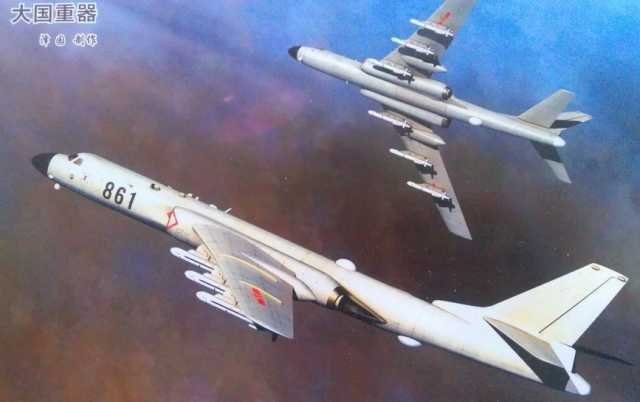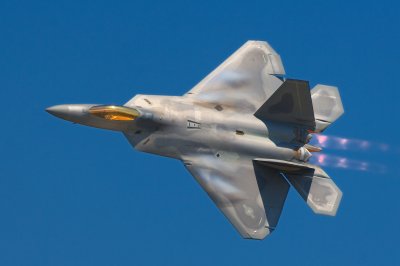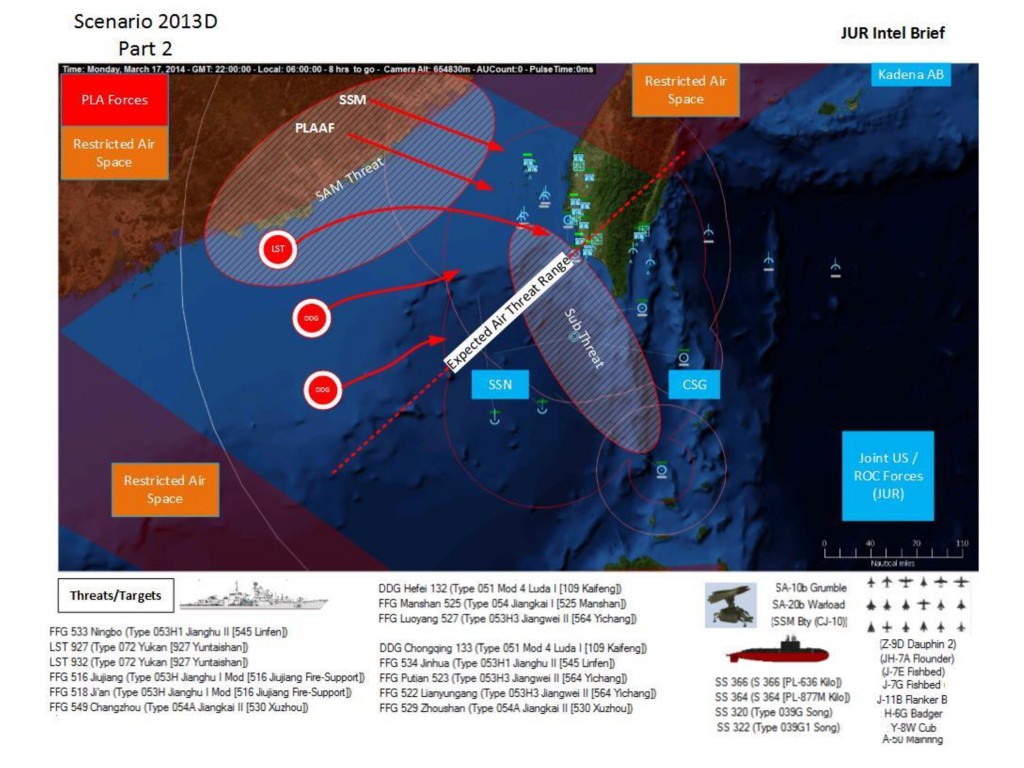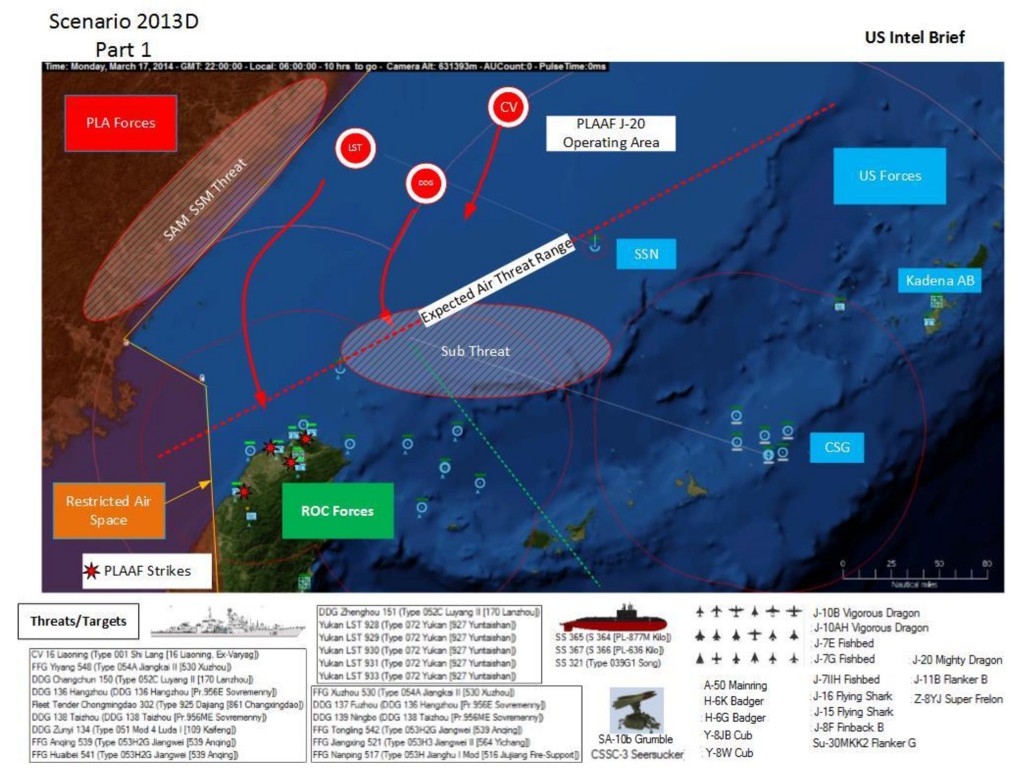New Command scenario: Mission 2013D – Part II
Author: steelp
In September, Mission 2013A, involved more than 40,000 troops from multiple services aimed at a large-scale island invasion either in the South China Sea or East China Sea where China has encountered strong resistance to its claims of territorial or maritime assets.
Code-named Mission 2013B, the exercises are the third installment this year of a series of military drills. Participating in the exercise are ground troops from the 42nd Army of the Guangzhou Military Region command — the military’s crack force that was the main fighting unit during the Korean War and the 1979 invasion of Vietnam.
Air force units, surface warships and amphibious vessels, and electronic warfare groups from the Guangzhou and Nanjing region commands also formed a key portion of the war games.
A third exercise, Mission 2013C, was conducted and directed primarily by the air force.
Mission 2013D has been activated.
China launches attack on Taiwan.
New Command scenario: Mission 2013D – Part I
 Author: steelp
Author: steelp
China PLAN / PLAAF
ROC / USAF / USN
Date/Time: Mar 2014 / 22:00:00 Zulu / 06:00:00 Local
Location: North Taiwan Straight
Playable Sides: United States
Introduction
2013 China
In September,2013, China commenced Mission 2013A, involved more than 40,000 troops from multiple services aimed at a large-scale island invasion either in the South China Sea or East China Sea where China has encountered strong resistance to its claims of territorial or maritime assets.
Following 2013A came Code-named Mission 2013B.The exercises were the third installment in 2013 of a series of military drills. Participating in the exercise are ground troops from the 42nd Army of the Guangzhou Military Region command — the military’s crack force that was the main fighting unit during the Korean War and the 1979 invasion of Vietnam.
Air force units, surface warships and amphibious vessels, and electronic warfare groups from the Guangzhou and Nanjing region commands also formed a key portion of the war games.
A third exercise, Mission 2013C, was conducted and directed primarily by the air force.
US INTEL confirmed the existance of a 2013 Delta exercise but it never was executed by China.
Dec 2013
China’s J20 program delivers an undisclosed number of aircraft to PLA air force for operational deployment.
Jan 2014
China accelerated the activation of its newest carrier the Shi Lang. Air assets were delivered and deemed carrier combat operational.
Feb 2014
China alerts international community and warns commercial traffic of its intent to hold a multi service exercise and evaluate its new naval structure in March. US / ROC plan joint exercise.
Mar 2014
1700Z. As US and ROC forces exercise into the third day of a week long joint naval operation some 150 miles east of the Taiwan straight, China executes mission 2013D. It is soon clear this is no exercise….
New Command scenario: Turkmen Bombardment
Author: Coiler
-TURKMEN PRESIDENT TO TURKMEN ARMED FORCES:
-THE FALL OF KABUL AND THE DECLARATION OF THE ISLAMIC EMIRATE OF AFGHANISTAN IS A MATTER OF GREAT CONCERN. YOU ARE TO LAUNCH AIRSTRIKES ON ANY IDENTIFIED TARGETS IMMEDIATELY TO SHOW THE RESOLVE OF THE TURKMEN GOVERNMENT. ALL AIR FORCE UNITS ARE TO BE READIED.
TOP SECRET COMMINQUE, TURKMEN AIR FOCE:
Situation:
-The Turkmen government, alarmed by the formation of the new Islamic Emirate of Afghanistan, has ordered airstrikes on enemy positions. There are more opportunities for conventional airstrikes now that a state has formed, and more targets due to the new government moving its heavy units north. The air force has objected on the grounds that its reconnassiance capability is nonexistent, yet the orders must be carried out.
Friendly Forces:
-As many MiG-29 and Su-25 aircraft as possible have been made operational at Mary-2 airbase. The Turkmen IADS is unreliable, so a mobile search radar from the air defense command has been rushed to provide spotting.
Enemy Forces:
-The IEA has captured much hardware left behind from the Soviet war. Expect artillery, tanks, AAA, and MANPADs. Su-17s pressed into service as fighters have been spotted patrolling the country’s airspace. Intelligence gathering has been extremely difficult, but citizens near the border have spotted many “suspicious vehicles” on the other side. Also, our intelligence contacts have given us the location of tent with a wide array of communications equipment near it, a sign of a major regional command post.
Mission:
-Destroy all valid targets you can find. Do not attack the airfields for fear of retaliation or escalation
Execution:
-Do not attack the airfield. Otherwise, all weapons free.
Command and Signal:
-Command: Mary-2 Airbase
EMCON State C: Unrestricted Emissions.
On “expected results” and the perils of overmodelling
 Recently there was an interesting discussion on the Matrix forum about various details of air combat modelling in Command. One of the residents enquired about the modelling of lopsided victories such as Bekaa valley:
Recently there was an interesting discussion on the Matrix forum about various details of air combat modelling in Command. One of the residents enquired about the modelling of lopsided victories such as Bekaa valley:
I do not have the nice data set prints as above, but I notice much the same sort of issue. E.G., play the Battle of the First Salvo scenario – and just watch the Syria/Israel air combat. Historically, in that time frame, the Israeli side routinely wipes up the Syrian Air Force – but in the simulation the Israelis lose several Eagles every time I run the scenario. Just struck me the last time I ran it that the on screen results should at least be near the ball park of real results.
This was a fair point, and prompted some reflection on the modelling priorities of Command as a simulation:
…and right there lies one of the biggest pitfalls for generic (ie. not battle/theater-focused) wargame/simulation engines: Over-specializing in order to closely match a specific historical result, at the expense of everything else.
Let’s take another similar example to make the peril more obvious. Say we’re developing a tactical land combat engine (think Steel Panthers), and our first litmus test is 73 Easting. We do some trial runs, and although US/UK forces trounce the Iraqi units as in RL, allied losses are usually higher than the minimal ones historically attained. This does not please our target audience (mil/gov or consumers, depending on the game) so we go back and endlessly tweak both data and algorithms until the game consistently recreates the absolute wipe-out of the real battle. Great job! Or we think so.
Now we take that engine and data and go to our next test, a WW3-CentFront scenario. We run it and NATO forces effortlessly shrug off massive Soviet attacks. Oops.
What happened? We overspecialized for 73 Easting’s kill scores.
A simulation does not need to consistently recreate (in terms of bean-counting) a specific historical outcome in order to be realistic. The outcome must certainly be one of the possible results (otherwise you have a real problem) but the true litmus test is whether the game results are often close to the historical outcome. If Iraqi forces are rolling all over allied armor in 73 Easting then definitely something is wrong. If allied forces are dominating but taking losses here and there, it is probably realistic enough.
Let’s say you’re simulating the first night of Desert Storm. If the game flows pretty much like the historical route, the bulk of the Iraqi IADS should be neutralized; that right there is your authenticity criterion. If a few F-117s are lost does this mean there is a problem in the sim? It is possible (and you have to check the logs to determine that), but a more likely explanation is that the RL Nighthawk crews were simply very lucky. (Many F-117 pilots have openly stated exactly that, and the campaign planners in fact expected several losses). Can you tweak the models & data so that no F-117 ever gets lost? Sure. But then you’ll probably never be able to recreate the Kosovo shootdown (and the second one that limped back to Aviano and was written off after crash-landing). Overspecializing again.
(As an aside, this is one of the reasons many wargame/sim designers prefer their releases to focus on a single battle or theater at a time. If all you have to worry about is 73 Easting or Medinah Ridge or Desert Storm in general, you’re free to massage your models and data to consistently recreate historical outcomes. Fulda Gap? Simply re-tweak the engine for that on the next release.)
So, back to Bekaa. Like 73 Easting this is an unusual mismatch that tempts you to tweak your engine to closely match it, but we’ve seen the dangers of doing that. Let’s break down the factors that enabled the IAF to dominate these engagements:
* Strong sensors jamming, particularly standoff radar jamming. Command supports this already.
* Very strong comms jamming, which effectively forced Syrian aircraft to rely almost exclusively on their own (usually inadequate) sensors instead of sharing a common tactical picture with the Syrian IADS. You can _sort of_ simulate this in Command right now by not having the big Syrian EW/GCI radars present (the end-user effect of not receiving cues from your IADS is the same one as the IADS not being there in the first place) but you still have the limitation of Syrian fighters freely communicating among themselves. We plan to model comms jamming better in the future.
* Sub-optimal placement of Syrian IADS elements (see here for elaboration: http://www.ausairpower.net/APA-SAM-Effectiveness.html). You can do this in Command already.
* Vast differences in pilot proficiency. Command supports this, but still allows a rookie pilot to pull the same tactical and evasive maneuvers as an ace (albeit with reduced evasion benefit). This is crucial, because in Bekaa many Syrian aircraft were attacked and destroyed while literally flying straight and level. Now, could we modify the code so that “advanced” evasion techniques are available only to highly proficient crews? We could, and fairly easily so, but this would then create a very strong incentive for a player handling the Syrian side to micromanage (e.g. “my pilots are not beaming by themselves so I’ll do it manually for them”). This runs contrary to one of our chief design tenets of Command: the player should not have to micromanage to win. So it’s a bind.
* Substantial differences in pilot visibility. This doesn’t matter much if a fighter has good onboard sensors and solid communication with the IADS, but when (a)your sensors are crap and/or jammed, (b)you are cut off from anyone else on your side because your comms are solid static and (c)your limited side- or rear- visibility prevents you from seeing the IAF fighter coming up on you under his own perfectly working IADS guidance, you end up exactly in the situation of being attacked and killed while flying straight and level. (As Coiler correctly pointed out, most IAF kills were the result of surprise slashing hit-and-run atacks, not artful dogfights). Command currently assumes a JSF-like 360-deg visibility for all aircraft and it is definitely something we want to improve (our DB master cries for mercy).
* Superior hardware and weapons (particularly AIM-9L vs AA-2). Nothing much to say about this, Command of course already models this.
* Superior grand-tactical/operational management of air assets. This is pretty much what Command expects of you, as the player, to achieve. Manouvering your aircraft to get in optimal engagement positions while preventing the enemy from doing the same, selecting the most suitable weapons for the task, reacting on-the-fly to changes in the tactical situation etc. The AI does a reasonable job at this (most of the time) but human intuition is still hard to beat, and AI vs AI clashes cannot reproduce the imbalance of skill that characterized Bekaa.
So, as you can see there is a whole range of factors that have to be taken into account when considering mismatches like Bekaa, and very few of them have to do with the weapon endgame interactions that the OP was inquiring about.
Another user chipped in:
One thing that hasn’t been noted is that you need to be careful when comparing to real world results because the real world results aren’t necessarily the “average.” To use the 73 Easting example, we don’t know whether the one-sided results were unavoidable due to the circumstances, or if the real world results were actually an outlier. We can run the sim 100 times to see what the average results are for the sim. We don’t have that option with the real world.
I’ve seen this problem noted in a game that included the Battle of Midway. In the game, the Japanese usually did better than they did historically. After much studying, our conclusion was that if you fought the real battle a number of times, the historical results were pretty much the best result that was possible. The game was likely giving more realistic results than the actual battle did.
Definitely an interesting discussion.
UPDATE: After this discussion, both the more realistic pilot visibility and comms-disruption were added as features in Command, enabling for the first time a truly realistic recreation of the Bekaa airbattle & tactics in the “Shifting Sands” DLC.
Red Flag, Raptors, smugglers and battlewagons: Six new Command scenarios available
 Miguel Molina has released a new version of the Command community scenario pack, the compendium of Command scenarios crafted by the user community.
Miguel Molina has released a new version of the Command community scenario pack, the compendium of Command scenarios crafted by the user community.
The new release contains six brand-new scenarios:
- Caribbean Clinch, 1956: The Suez conflict has gone downhill in a big way. The Soviet Union has intervened on Egypt’s behalf and atacked Israeli, British and French forces. The US, far from simply reigning in their NATO allies, are now forced to actively participate. Around the world, US forces are mobilizing to engage Soviet and Warsaw Pact forces in their immediate vicinity. In the southern Caribbean, this means your SAG force, centered on the batleship Iowa and the prototype missile cruiser Canberra, is about to taste blood. What are you up against?
- Vivid Sentry, 2018: In the near future, tensions between Venezuela and the Netherlands continue to mount. Venezuela repeatedly harasses Dutch vessels and aircraft en route to and from Aruba. The Dutch government attempts to control the situation by moving naval vessels into the region as a “show of force” to demonstrate their commitment to their Caribbean territories. This gives Venezuela the opportunity they have been waiting for.
- Salalah station, 1986: The civil war in Yemen has led to the government firing on targets in western Oman. Oman responded by bombing targets in eastern Yemen. Yemen has declared war on Oman and both sides have requested assistance from their allies, the Soviet Union and United States respectively. The Soviets have sent several ships into the area and are using various diplomatic and economic channels to pressure and punish Oman. The United States, having to tread a fine line between insufficient support and uncontrollable escalation, has moved a small task force into the region.
- Operation Square Peg, 2013: Although designed as a superlative fighter, the F-22 also has a secondary strike role. How capable is the Raptor in this task? Find out in a time-critical strike against chemical weapon targets in Syria.
- Needle in a Wet Haystack, 2009: Think that the USCG counter-drug/smuggler patrols are hard? Step into the shoes of the Ecuadorian coast guard and try to pick out and prosecute the smuggler submarines. And maintain your sanity.
- A Day at Red Flag, 1977: The Red Flag exercises introduced in the 1970s brought a new level of realistic training to the American air forces. This early Red Flag features the USAF’s fighter squadrons against highly trained Aggressors in a mission to attack a heavily defended target.
As always, the community scenario pack is available for download at the Command downloads page on the WarfareSims site: http://www.warfaresims.com/?page_id=1876







